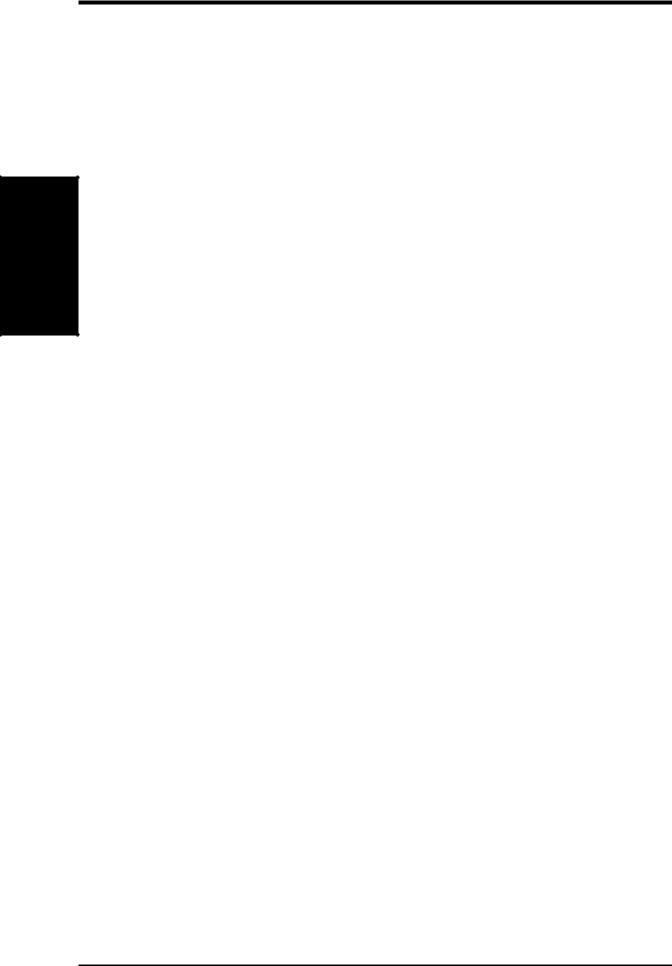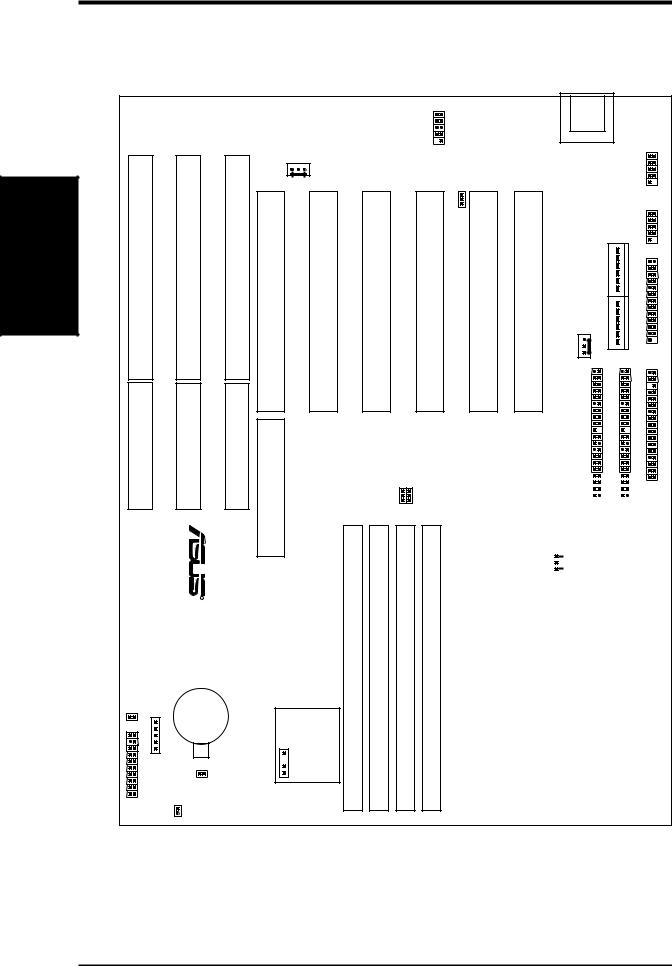ASUS PI-P65UP5C-PKND, P65UP5-P6ND User Manual







 R P/I P65UP5
R P/I P65UP5
Baseboard for CPU Cards
USER’S MANUAL

USER'S NOTICE
No part of this manual, including the products and softwares described in it, may be reproduced, transmitted, transcribed, stored in a retrieval system, or translated into any language in any form or by any means, except documentation kept by the purchaser for backup purposes, without the express written permission of ASUSTeK COMPUTER INC. (“ASUS”).
ASUS PROVIDES THIS MANUAL “AS IS” WITHOUT WARRANTY OF ANY KIND, EITHER EXPRESS OR IMPLIED, INCLUDING BUT NOT LIMITED TO THE IMPLIED WARRANTIES OR CONDITIONS OF MERCHANTABILITY OR FITNESS FOR A PARTICULAR PURPOSE. IN NO EVENT SHALL ASUS, ITS DIRECTORS, OFFICERS, EMPLOYEES OR AGENTS BE LIABLE FOR ANY INDIRECT, SPECIAL, INCIDENTAL, OR CONSEQUENTIAL DAMAGES (INCLUDING DAMAGES FOR LOSS OF PROFITS, LOSS OF BUSINESS, LOSS OF USE OR DATA, INTERRUPTION OF BUSINESS AND THE LIKE), EVEN IF ASUS HAS BEEN ADVISED OF THE POSSIBILITY OF SUCH DAMAGES ARISING FROM ANY DEFECT OR ERROR IN THIS MANUAL OR PRODUCT.
Products and corporate names appearing in this manual may or may not be registered trademarks or copyrights of their respective companies, and are used only for identification or explanation and to the owners’ benefit, without intent to infringe.
•Intel, LANDesk, and Pentium are registered trademarks of Intel Corporation.
•IBM and OS/2 are registered trademarks of International Business Machines.
•Symbios is a registered trademark of Symbios Logic Corporation.
•Windows and MS-DOS are registered trademarks of Microsoft Corporation.
•Sound Blaster AWE32 and SB16 are trademarks of Creative Technology Ltd.
•Adobe and Acrobat are registered trademarks of Adobe Systems Incorporated.
The product name and revision number are both printed on the board itself. Manual revisions are released for each board design represented by the digit before and after the period of the manual revision number. Manual updates are represented by the third digit in the manual revision number.
For previous or updated manuals, BIOS, drivers, or product release information, contact ASUS at http://www.asus.com.tw or through any of the means indicated on the following page.
SPECIFICATIONS AND INFORMATION CONTAINED IN THIS MANUAL ARE FURNISHED FOR INFORMATIONAL USE ONLY, AND ARE SUBJECT TO CHANGE AT ANY TIME WITHOUT NOTICE, AND SHOULD NOT BE CONSTRUED AS A COMMITMENT BY ASUS. ASUS ASSUMES NO RESPONSIBLITY OR LIABILITY FOR ANY ERRORS OR INACCURACIES THAT MAYAPPEAR IN THIS MANUAL, INCLUDING THE PRODUCTS AND SOFTWARES DESCRIBED IN IT.
Copyright © 1997 ASUSTeK COMPUTER INC. All Rights Reserved.
Product Name: |
P/I-P65UP5 |
Manual Revision: |
2.04 |
Release Date: |
July 1997 |
2 |
ASUS P/I-P65UP5 User’s Manual |

ASUS CONTACT INFORMATION
ASUSTeK COMPUTER INC.
Marketing Info
Address: |
150 Li-Te Road, Peitou, Taipei, Taiwan 112, ROC |
Telephone: |
+886-2-894-3447 |
Fax: |
+886-2-894-3449 |
Email: |
info@asus.com.tw |
Technical Support
Fax: +886-2-895-9254
BBS: +886-2-896-4667
Email: tsd@asus.com.tw
WWW: www.asus.com.tw
Gopher: gopher.asus.com.tw
FTP: ftp.asus.com.tw/pub/ASUS
ASUS COMPUTER INTERNATIONAL
Marketing Info
Address: |
721 Charcot Avenue, San Jose, CA 95131, USA |
Telephone: |
+1-408-474-0567 |
Fax: |
+1-408-474-0568 |
Email: |
info-usa@asus.com.tw |
Technical Support
BBS: +1-408-474-0569
Email: tsd-usa@asus.com.tw
WWW:www.asus.com
ASUS COMPUTER GmbH
Marketing Info
Address: |
Harkort Str. 25, 40880 Ratingen, BRD, Germany |
Telephone: |
49-2102-445011 |
Fax: |
49-2102-442066 |
Email: |
info-ger@asus.com.tw |
Technical Support
BBS: 49-2102-448690
Email: tsd-ger@asus.com.tw
Hotline: 49-2102-499712
ASUS P/I-P65UP5 User’s Manual |
3 |

CONTENTS
I. INTRODUCTION ......................................................... |
7 |
How this Manual is Organized ........................................................ |
7 |
Item Checklist .................................................................................. |
7 |
Features of the ASUS P/I-P65UP5 Baseboard ................................ |
8 |
II. FEATURES .................................................................. |
8 |
Parts of the ASUS Baseboard .......................................................... |
9 |
III. INSTALLATION ..................................................... |
10 |
ASUS Baseboard Layout ............................................................... |
10 |
Installation Steps ............................................................................ |
12 |
1. Jumpers ...................................................................................... |
12 |
Jumper Settings .................................................................. |
13 |
2. System Memory (DRAM/SDRAM & SRAM) ........................ |
16 |
DRAM Memory Installation Procedures ............................ |
17 |
3. Central Processing Unit ............................................................ |
18 |
System Case ........................................................................ |
18 |
4. Expansion Cards ....................................................................... |
20 |
Expansion Card Installation Procedure .............................. |
20 |
Assigning IRQs for Expansion Cards ................................. |
20 |
Assigning DMA Channels for ISA Cards ........................... |
21 |
5. External Connectors .................................................................. |
22 |
IV. ASUS PCI SCSI Cards ............................................ |
28 |
Symbios SCSI BIOS and Drivers .................................................. |
28 |
ASUS PCI-SC200 & PCI-SC860 SCSI Cards .............................. |
28 |
Setting Up the ASUS PCI-SC200 & PCI-SC860 ..................... |
29 |
Setting the INT Assignment for the ASUS PCI-SC200 ........... |
29 |
Terminator Requirements for SCSI Devices ............................ |
29 |
Terminator Settings for the ASUS PCI-SC860 ........................ |
30 |
Terminator Settings for the ASUS PCI-SC200 ........................ |
30 |
SCSI ID Numbers for SCSI Devices ....................................... |
31 |
SCSI ID Priority ....................................................................... |
31 |
V. ASUS I-A16C Audio Card ........................................ |
32 |
ASUS I-A16C Audio Features ................................................. |
32 |
Layout and Connectors ............................................................ |
32 |
Connectors .......................................................................... |
32 |
CD-Audio Connector Pin Definitions ...................................... |
32 |
4 |
ASUS P/I-P65UP5 User’s Manual |

(This page was intentionally left blank.)
ASUS P/I-P65UP5 User’s Manual |
5 |

FCC & DOC COMPLIANCE
Federal Communications Commission Statement
This device complies with FCC Rules Part 15. Operation is subject to the following two conditions:
•This device may not cause harmful interference, and
•This device must accept any interference received, including interference that may cause undesired operation.
This equipment has been tested and found to comply with the limits for a Class B digital device, pursuant to Part 15 of the FCC Rules. These limits are designed to provide reasonable protection against harmful interference in a residential installation. This equipment generates, uses and can radiate radio frequency energy and, if not installed and used in accordance with manufacturer's instructions, may cause harmful interference to radio communications. However, there is no guarantee that interference will not occur in a particular installation. If this equipment does cause harmful interference to radio or television reception, which can be determined by turning the equipment off and on, the user is encouraged to try to correct the interference by one or more of the following measures:
•Re-orient or relocate the receiving antenna.
•Increase the separation between the equipment and receiver.
•Connect the equipment to an outlet on a circuit different from that to which the receiver is connected.
•Consult the dealer or an experienced radio/TV technician for help.
WARNING! The use of shielded cables for connection of the monitor to the graphics card is required to assure compliance with FCC regulations. Changes or modifications to this unit not expressly approved by the party responsible for compliance could void the user's authority to operate this equipment.
Canadian Department of Communications Statement
This digital apparatus does not exceed the Class B limits for radio noise emissions from digital apparatus set out in the Radio Interference Regulations of the Canadian Department of Communications.
6 |
ASUS P/I-P65UP5 User’s Manual |

I. INTRODUCTION
How this Manual is Organized
This manual is divided into the following sections:
I. Introduction: |
Manual information and checklist |
II. Features: |
Information and specifications concerning this product |
III. Installation: |
Instructions on setting up the baseboard |
IV. SCSI Cards: |
Installation of ASUS SCSI cards (optional) |
Item Checklist
Please check that your package is complete. If you discover damaged or missing items, please contact your retailer.
ASUS P/I-P65UP5 baseboard
C-P6ND, C-P55T2D, or C-PKND CPU card
2 serial port ribbon cables attached to a mounting bracket
1 parallel ribbon cable with mounting bracket
1 IDE ribbon cable
1 floppy ribbon cable
This user’s manual
Infrared module (optional)
USB cable with mounting bracket set (optional)
ASUS PCI-SC200 Fast SCSI or PCI-SC860 Ultra-Fast SCSI card (optional)
ASUS I-A16C audio card and manual* (optional)
*Online help is provided with the Creative 16X audio drivers. A separate manual is provided for the Creative 16C Series audio drivers.
I. INTRODUCTION |
(Manual / Checklist) |
|
|
ASUS P/I-P65UP5 User’s Manual |
7 |

FEATURES .II (Features)
II. FEATURES
Features of the ASUS P/I-P65UP5 Baseboard
The P/I-P65UP5 is carefully designed for the demanding PC user who wants great versatility in a computer system. This baseboard:
•Easy Installation: Is equipped with BIOS that supports autodetection of hard drives and Plug and Play to make setup of hard drives and expansion cards virtually automatic.
•Desktop Management Interface (DMI): Supports DMI through BIOS, which allows hardware to communicate within a standard protocol creating a higher level of compatibility. (Requires DMI-enabled components.)
•Versatile Processor Support: Supports dual 75–233MHz Pentium, 150– 200MHz Pentium Pro, 233–333MHz Pentium II processors.
•Versatile DRAM Memory Support: Supports eight 72-pin SIMMs of 4MB, 8MB, 16MB, 32MB, 64MB to form a memory size between 8MB to 512MB. Supports both Fast Page Mode (FPM), and Extended Data Output (EDO) SIMMs. Burst Extended Data Output (BEDO) supported with the C-P6ND CPU card.
•ISA and PCI Expansion Slots: Provides three 16-bit ISA slots, four 32-bit PCI slots, and one PCI/MediaBus shared slot for either a standard PCI card or ASUS MediaBus Card.
•ASUS MediaBus: Features an expansion slot extension shared with PCI Slot 5 for an optional high-performance expansion card, which includes two functions in one easy-to-install card.
•Super Multi-I/O: Provides two high-speed UART-compatible serial ports and one parallel port with EPP and ECP capabilities. Supports two of either 5.25or 3.5-inch disk drives (1.44MB or 2.88MB) without an external card.
•PCI Bus Master IDE Controller: Comes with an onboard PCI Bus Master IDE controller with two connectors that supports four IDE devices in two channels, supports PIO Modes 3 and 4 and Bus Master IDE DMA Mode 2, and supports Enhanced IDE devices such as Tape Backup and CD-ROM drives.
Supports Japanese standard “Floppy 3 mode” (3.5-inch disk drive: 1.2MB) and LS-120 floppy disk drives (3.5-inch disk drive: 120 MB, 1.44MB, 720K). BIOS supports IDE CD-ROM or SCSI device boot-up.
•Optional IrDA Module: Supports an optional infrared port module for wireless file transfers and communication.
•SCSI BIOS: Supports optionalASUS SCSI controller cards through onboard firmware.
•Intelligence: Supports Fan Status Monitoring and Alarm, Temperature Monitoring and Alert, Voltage Monitoring and Alert, System Resources Alert, and Virus Write Protection through the optional onboard LM78 Hardware Monitor and Intel® LANDesk Client Manager (LDCM) software.
8 |
ASUS P/I-P65UP5 User’s Manual |

II. FEATURES
Parts of the ASUS Baseboard
Universal |
Super |
Serial Bus |
Multi-I/O Keyboard |
Programmable
Flash ROM
4 PCI Slots
II. FEATURES (Parts of Board)
CPU Card Slot
PCI 5 or ASUS
MediaBus
3 ISA Slots
Infrared Module
Support
LM78
Hardware Monitor (Optional)
(8) 72-pin SIMM Sockets
ASUS P/I-P65UP5 User’s Manual |
9 |

III. INSTALLATION
ASUS Baseboard Layout
INSTALLATION .III Layout) (Board
Keyboard
|
|
|
|
|
|
Universal Serial Bus |
|
|
1 COM |
Serial |
||
ISA |
ISA |
ISA |
|
FANPWR3 |
|
|
JP1 |
|
|
|
||
3 Slot |
2 Slot |
1 Slot |
MediaBus/5SlotPCI |
4SlotPCI |
3SlotPCI |
2SlotPCI |
Enable/Disablei/O-Multi |
1SlotPCI |
SlotCardCPU |
P8P9 |
InputPowerBoard |
PortParallelPorts |
|
|
|
|
|
|
|
|
|
|
|
COM2 |
|
|
|
|
|
|
|
|
|
|
|
FANPWR1 |
|
|
|
|
|
|
|
|
|
|
|
|
IDE Primary |
IDE Secondary |
Drives Floppy |
IDE LED |
|
Case |
Con Infrared |
Connector |
|
JP2
JP3
BUS Freq.
R |
Socket SIMM |
Socket SIMM |
Socket SIMM |
Socket SIMM |
|
0) (Bank 2 |
1) (Bank 4 |
2) (Bank 6 |
3) (Bank 8 |
CR2032 3Volts |
|
|
|
|
Lithium Cell |
|
|
|
|
BIOS Power |
Hardware |
|
|
Monitor |
|
|
LM78 |
|
|
|
|
JP9
Chassis Conn.
Battery Test
JP7
RTC RAM
Operation/Clear CMOS
|
|
|
|
|
|
|
|
|
|
|
|
|
|
Slot Card CPU |
|
|
|
|
|
|
|
|
|
|
|
|
|
|
|
|
|
|
|
|
|
|
|
|
|
|
|
|
|
|
|
|
|
|
|
|
|
|
|
|
|
|
|
|
|
|
|
|
|
|
|
||||
|
|
1 Socket SIMM |
|
|
3 Socket SIMM |
|
5 Socket SIMM |
|
7 Socket SIMM |
||||
|
|||||||||||||
|
|||||||||||||
FANPWR2 |
|||||||||||||
|
|
|
|
0) (Bank |
|
|
1) (Bank |
|
2) (Bank |
|
3) (Bank |
||
|
|
|
|
|
|
|
|
|
|
|
|
|
|
|
|
|
|
|
|
|
|
|
|
|
|
|
|
The items in outline are only available on the baseboard with onboard LM78 Hardware Monitor.
10 |
ASUS P/I-P65UP5 User’s Manual |
